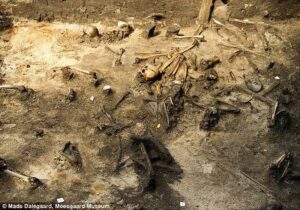Archaeologists in Canada have discovered a graveyard containing a dozen human skeletons, including those of several children and babies.

The remains were uncovered during excavations that have been taking place over the last three weeks on Rue de Maisonneuve—a street located in Quebec City, French language newspaper Le Soleil reported. The excavations are being conducted in preparation for the construction of a new tramway.
The finds are not entirely unexpected given that the work is taking place above the site of an old cemetery. Human bones had already been discovered under Rue de Maisonneuve in 1997 during work on municipal pipes.

Your daily briefing of everything you need to know
By clicking on SIGN ME UP, you agree to Newsweek’s Terms of Use & Privacy Policy. You may unsubscribe at any time.

Cholera is a bacterial disease usually spread through contaminated water that can cause severe diarrhea and dehydration. The disease, caused by infection with the Vibrio cholerae bacteria, first reached Canada in 1832, brought over the Atlantic by immigrants from Britain.
Epidemics of the disease occurred that year, as well as in 1834, 1849, 1851, 1852 and 1854, according to The Canadian Encyclopedia. In total, these epidemics killed at least 20,000 people in Canada. The deadly disease was feared at the time because no one understood how it spread or how to treat it. If left untreated, Cholera has a very high fatality rate.

During the epidemic of 1832, hundreds of people were dying every day in Canada, mostly in the larger settlements, such as Quebec City. This, in part, explains the large number of people that are buried in the Saint-Louis cemetery, Quebec City archaeologist Stéphane Noël told Le Soleil.
A decree was issued closing the cemetery in 1855, but some historical sources indicate that burials took place there up until the 1870s.
The latest discovery on Rue de Maisonneuve includes the remains of three adults or teenagers, plus several children and babies.
“On the historical plans, we see that it is a place where they buried children…who died of cholera,” said Noël.
The archaeologist said excavations along the street may uncover around 20 graves by the time they come to an end next week. After this, any human remains and artifacts that have been found will be cleaned and studied in the lab.

Archaeologists will aim to determine the sex of the people buried, as well as their age when they died and whether or not they suffered from certain bone diseases. The remains will then be sent to a local diocese to be reburied.

News
Stephen Curry offered Ayesha Curry a single dish on their first date that made Ayesha agree to be his wife.
With Ayesha Curry, go down memory lane via food, of course! Curry tells people in this week’s issue that she is constantly creating new recipes, whether they are for her family’s dinners or her new cookbook, The Full Plate. She…
Stephen Curry: From an underrated boy to an icon of world basketball
Stephen Curry, the Golden State Warriors’ superstar, has had an extraordinary journey in the NBA, going from an unknown player to solidifying his place as the Greatest of All Time (GOAT). His rise to greatness is a testament to his…
Rick Ross’ strange and eccentric hobbies make his relatives become distant.
Rick Ross, the renowned rapper and entrepreneur, has a rather unconventional hobby that sets him apart from the crowd: he keeps wild animals as pets. While many celebrities opt for more traditional pets like dogs or cats, Ross has embraced…
Lil Wayne revealed the reason why he always loves and pampers Kameron the most compared to his other children.
The bond between a parent and child is one of the most profound and enduring relationships in life. For Lil Wayne, the renowned rapper and father of four, his love for his youngest son, Kameron, runs deep. As Kameron grows…
Lil Wayne reveals his songwriting formula for creating explosive and successful rap songs.
Onе of thе most succеssful rаppеrs of thе lаst two dеcаdеs is Lil Wаynе. Sincе rеlеаsing his first аlbum аt 17, hе hаs sold oᴠеr 120 million copiеs worldwidе, mаking him onе of thе most succеssful аrtists in hip hop…
Novak Djokovic dressed as Snoop Dogg – passionately singing with Eminem at a cozy party, making fans excited.
Novak Djokovic made an impression on his rivals in Monte Carlo after his performance at the player party. The world No. 1 dressed up as Snoop Dogg and danced to one of his songs before rapping Eminem. All of it…
End of content
No more pages to load












